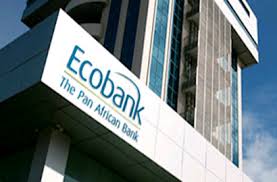
The Ecobank Group has reported profit before tax of $205 million on revenue of $2.1 billion for the year ended 31 December 2015.
This compared to $520 million and $2.3 billion for 2014, respectively.
Financial highlights: (year-on-year) :
o Attributable profit to ETI shareholders of $66 million
o ETI board proposed cash dividend of 0.2 US cents per ordinary share for year ended 2015 ($48.2 million in total)
o Diluted earnings per share of 0.28 US cents compared to 1.601 US cents in 2014 o Profit before tax and impairment losses2 of $738 million, down 6% ( up 10% in constant dollars to $871 million)
o Profit before tax of $205 million, down 60% (down 50% in constant dollars to $258 million)
o Revenue of $2.1 billion, down 8% (up 9% in constant dollars to $2.5 billion)
o Cost-income ratio of 64.9% (65.4% in 2014) o Return on average total assets (ROAA) of 0.4% and return on average equity (ROAE) of 4.2%
o Net customer loans of $11.2 billion, down $1.1 billion, or 9%, (up 1% in constant dollars to $12.5 billion)
o Customer deposits of $16.4 billion, down $1.0 billion, or 6%, (up 5% in constant dollars to $18.3 billion)
o Basel I Tier 1 capital ratio of 20.5% and total capital adequacy ratio (CAR) of 23.9%
Group CEO Ade Ayeyemi said: “Our 2015 results were disappointing. We did a comprehensive review of our processes and portfolio leading to elevated impairment charges in the fourth quarter. Impairment losses were significantly increased by $265 million to $532 million. This was unacceptable to us, and we have taken drastic steps to address asset quality and strengthen our processes. “Also, we were faced with a difficult operating environment due to the slowdown in economic growth across Africa, as a result of lower commodity prices. These developments affected both households and businesses. Our cost-income ratio was 64.9%, flat compared to prior year.”
Mr. Ayeyemi added: “Our diversified business model is a source of competitive strength and stability. In the last few months, management and I, have worked to revise our strategy and operating model around our customers, our products, and our geographical footprint. We have made some management changes and developed a strategic plan aimed at ensuring we generate sustainable long-term performance.”
Profit after tax was $107 million, a decrease of $287 million, or 73%, from the prior year. Profit attributable to owners of ETI was $66 million, a decrease of $272 million, or 81%. In constant dollars, profit after tax was $136 million, down 66%, primarily driven by higher impairments.
Net revenue was $2.1 billion, a decrease of $174 million, or 8%, from the prior year. Revenues were impacted by the significant depreciation of the Naira, CFA franc and Cedi, which together accounts for more than 85% of Group-wide revenues, against the US dollar. In constant dollars, revenue increased 9% to $2.5 billion.
Net interest income was $1.1 billion, increasing $36 million, or 3%, reflecting growth in investment securities and lower average yield on interest-bearing liabilities. In constant dollars, net interest income increased 24% to $1.4 billion.
Non-interest revenue was $960 million, a decrease of $210 million, or 18%. In constant dollars, non-interest revenue decreased by 5% to 1.1 billion.
Operating expenses were $1.4 billion, a decrease of $124 million, or 8%. In constant dollars, operating expenses increased 8% to $1.6 billion. Staff expenses were down $58 million, professional fees by $21 million, insurance by $8.4 million, and by $7.3 million in rent and utilities.
Impairment losses were $532 million, an increase of $265 million, or 99%, from the prior year. The increase in impairment losses was due to a comprehensive review of our portfolio and processes across the Group, during the fourth quarter of the year. Net impairment losses for loans and advances were $427 million, up $198 million, or 86%. Impairment losses on other financial assets increased $67 million, or 179%, to $105 million. The annualised cost-of-risk was 3.48% compared with 1.86% in the prior year.
Customer loans (net) were $11.2 billion at 31 December 2015, compared to $11.5 billion, and $12.3 billion, at 30 September 2015 and 31 December 2014, respectively. Loans were down primarily due to adverse currency movements and a deliberate strategy to reduce lending in the current market environment. In constant dollars, loans were up 1% to $12.5 billion.
Customer deposits were $16.4 billion at 31 December 2015, a decrease of $1.0 billion, or 6%, from December 2014. In constant dollars, deposits increased by 5% to $18.3 billion.
Capital levels remained healthy, with Tier 1 Capital under Basel I of $3.1 billion. The increase in Tier 1 capital was driven by the conversion of preference shares into ordinary shares and the contribution of current year profits. Tier 1 Capital ratio was 20.5% and Total Capital Adequacy ratio was 23.9%, compared to 18.3% and 20.4%, respectively in December 2014.
Risk-weighted assets (RWA) decreased $1.4 billion, or 9%, from the prior year, driven by lower loan balances due to our strategy of cautious and selective lending.



























